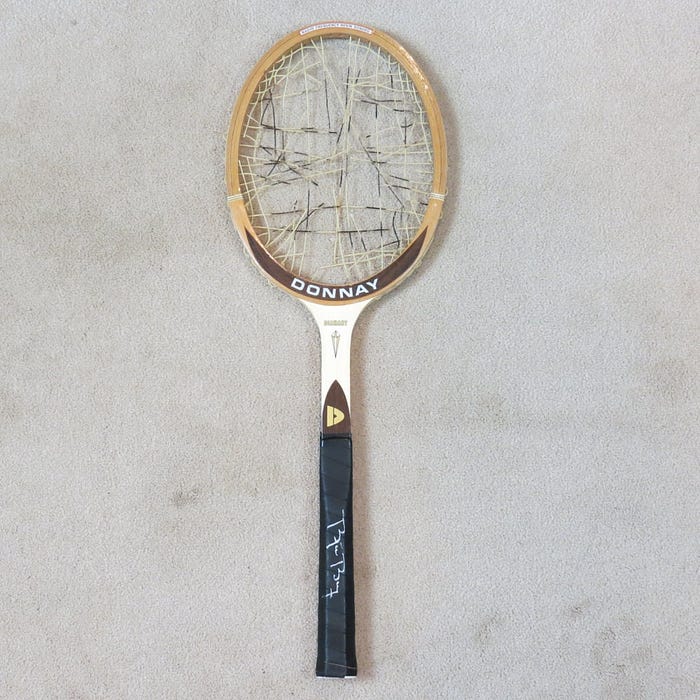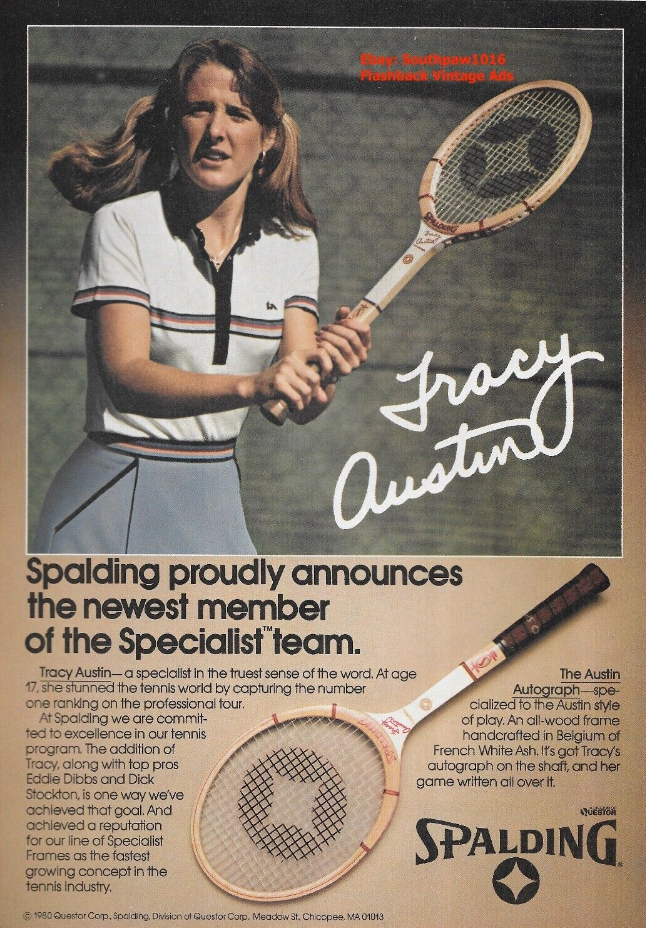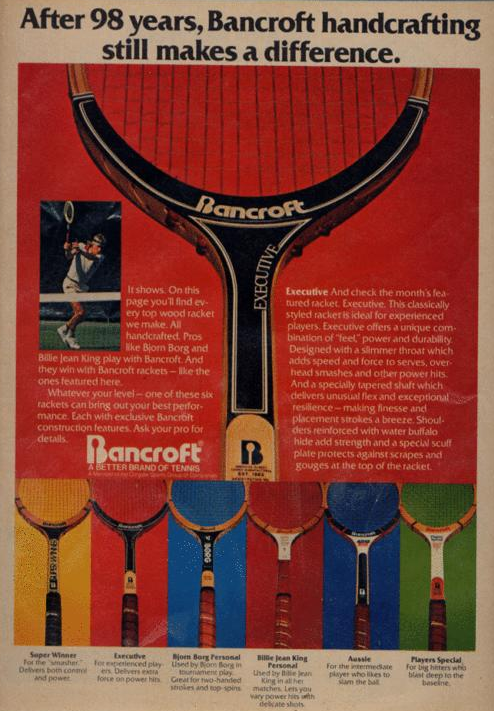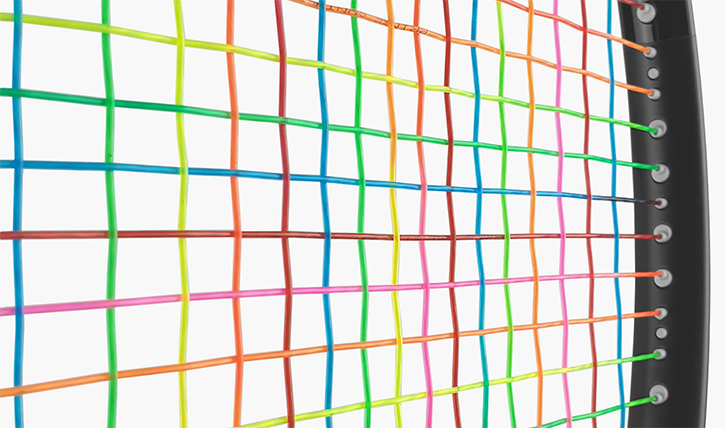Bjørn Borgs Preferred Rackets 1971–1982
How many Rackets did Bjørn Borg Rackets Use?
Bjørn Borg won 11 Grand Slams singles (six French, five Wimbledon) in the space of eight years, but the Swede quit the sport at only 26 at his peak! It is sometimes said that Borg used only two rackets in his career, and maybe you recall one: the famous Donnay black and red model called the Pro. This was a 18×19 13.10 oz / 371g model. Although his actual racket from the 1980 wimbledon final may have been 415g and sold at auction for £6600!
Björn Borg actually played with multiple racquets from four companies during his career; the big names being — Bancroft mainly whilst playing in the US between 1975 and 1980; Donnay of course when playing in Europe and lesser known Slazenger Challenge rackets he used when he was a teenager up to around 1974.

This is a first generation Bjorn Borg Donnay Diamant Match used racquet. This was used prior to Borg using Fairway grips exclusively on all his racquets so the grip is black and much thinner leather.

This is a special match used Racquet from Bjorn Borg. His coach Lennart Bergelin had this one put away after the 1977 Wimbledon tournament. It was restrung in order to have it put on display at several museums around Sweden.

A special and rare Racquet. This looks to be a painted Borg pro made to look like a Bancroft. Notice on the butt cap, you can see the B sticker over the D for Donnay that is screened on the plastic.

Bjorn Borg Pro used in matches. He started with the Allwood before he switched to this which was very similar with the same large frame at the base of the flake or neck.

Borg used this racket at the 1978 US Open. It had a special grip extension with 6 tiny nails extending one Fairway grip to another.

My favorite of the Borg rackets is the Borg Signature from Bancroft, but this isn’t his actual model but a very close tribute. He actually used the “Bancroft Diamant” “Bancroft Personal” and then the “Donnay Allwood”. As his career because stratospheric companies scambled to bring out Borg special editions. For example in 1982 Donnay brought out the Bjorn Borg Pro which became a massive seller!
Even by modern standards the rackets which bear his name are strikingly beautiful. Slazenger, Bandcroft and early Donnays were a classic design of wooden laminated layers usually made of ash and maple with gut strings. Somehow the oval head has perfect proportions and the contrasting black throat with white text simply iconic! It is finished off by a brown leather grip. However…..there is one racket everybody has forgotten. In fact there are hardly any photos
Borg’s 1991 Secret Racket

In 1991, Borg surprised everyone when he came out of retirement to play in Monte Carlo. After 10 years out, the world of tennis and the technology of rackets had changed enormously. Wood had long gone. Aluminium had come and gone. Fibreglass had come and gone. Complex graphite/carbon composites were taking over. But Borg felt he would play better with a wooden racquet and said “I had never played with anything else.” Deep down he knew it was a mistake. “I knew that if I wanted to do well I had to use another racket but I thought, you know: why change?”.
At least he did one thing he approached Grays of Cambridge to make a new racket for him. They copied the Donnay Borg Pro. 10 were made in secret and shipped to him in London where he would train for his comeback. The San Diego Union-Tribune said it was “Like showing up in Iraq with a musket,”
A practice match was arranged against fellow Swede and world number 93 Lars Jonsson on the centre court at the Monte Carlo Country Club. He practiced with Goran Ivanisevic and Boris Becker. Becker said “He hits with no power,” noticing the problem with 1980s technique and 1940s technology.
He lost to jorde aressi 6–2,6–3. Arrese was ranked number 52 in the world.
He never had a chance. Although he was still in top physical condition, his shots looked ludicrously soft, floating lazily across the net before taking a beating from Jordi Arrese’s oversized racket. Borg switched to a donnay pro one mid (the orange one) the next year and quietly canceled his plans to enter the French Open.
“I played no practice, no exhibitions, I just kind of turned up.It was madness; I knew that. I knew I was not playing well. But I can’t explain it except to say I wanted to play.
When Wood Was King
Wood was the only game in town for a hundred years! Sure wood had problems, too heavy, too flexy but they were lethal in the right hands. Sure big hands, attached to big forarms!
Initially wooden rackets were made from one or more solid sticks of ash bent to the required shape and glued with ‘animal glues’. Mechanisation in the 1940’s allowed a larger number of thinner ‘veneers’, bonded with urea-formaldehyde adhesives bent to shape and so that the natural variability in wood could be ‘averaged out’.
In addition to ash, other wood types including maple, sycamore and hornbeam have been used in the main frame member to provide desirable strength and stiffness properties; hickory, for wear resistance in the outer layer; beech and mahogany for throat and handle cosmetics and obeche as a lightweight filler in the shaft
One improvement by Spalding in 1905 was a locked wedge that was inserted into the throat of the racquet to reinforce its weakest point. Then in 1915 Bancroft patented the 3-ply laminated racquet, which had a strip of leather sandwiched between 2 outer wooden layers, resulting in greater strength and flexibility. This gradually increased until some had 18 layers of ply strips!
Different woods gave slightly different feel and stiffness. Dunlop Maxply McEnroe was made from Maple, Hickory, Vulcanized Fiber, Beech, Ash, with Fiberglass reinforced shoulders. While the Snauwaert Brian Gottfried Autograph was made using All White Ash, Vulcanized Fiber Laminated Shaft and Bow.
Wilson and Dunlop perfected lamination. Multiple thin layers that were bent cold and glued together under intense pressure. The innovation increased stability and decreased physical weight. Even by those days, 400g rackets were hard to use! Other innovations were longer handles (longer leather grips more precisely) for two handed backhands which slowly came in during the 1960s. Tiny gromets were introduced in the 1970s, stabilizing the strings, and fibre-glass laminates and hollow wood handles came in at the death in the 1980s.
But in 1976, Howard Head bolding made a giant 110″ racket to help himself play better. The main issue was the strings snapped where they went thru the metal frame. But grommets came to the rescue. It worked but on the court nearly everyone laughed. Those people had already spent 20 years learning how to play with 60–70 inch rackets. These people didn’t need or want these monstrosities! A group of ex-pros wrote to the ITF complaining but sales were big, and so no change was made.
Why Do Big Rackets Always Win?
Composite materials allow a large head size which is not too flexy. Head sizes went up from 65 to 85″ within 5 years. These were called “mid” sized rackets and once again, the tennis commuity scoffed at them. “You must be really bad if you need that kind of assistance.” Ironically simply physics shows a large head size usually wins in a like-for-like race for points.
Why? It is because alarge head size irons out a lot of inaccuracies of the modern game. An 65″ (7” diameter) 1980s racket is perfectly good for flat shots and serve and volleys. However, heavy topspin requires a steep upward angle (eg 45deg) and a down-ward “closed” racket face (-20deg). This means the ball only sees a fraction of the strings. In fact …..
a 11″ diameter (95″ sq) racket now, would be roughly the same as a 11″ diameter racket then (65″ sq ) in terms of playable area

The surprise early success of heavy metal rackets in the early 1970’s led to experimentation with other nontraditional materials, particularly glass fibre and the newly developed carbon fibre (usually referred to as ‘graphite’). These were expensive and initially rather heavy but by 1982 although Chris Evert won Wimbledon with a wooden racket it would be the last; Martina Navratilova and Mats Wilander won the French Open with an early composite Yonex R-7 . In 1983 even McEnroe switched to a mid-sized graphite Dunlop G200 after his brother recommended it. Wood fought back with mid-sized wooden rackets with graphite/carbon reinforcement but progress spelled the death knell for all well-known wood makers eg Donnay in Belgium and Bancroft in the U.S., both of which eventually disappeared as independent companies.

Modern composite rackets are around 30% lighter and three times stiffer than their state of the art wooden counterparts. Wooden rackets are still collectible, often surprisingly effective and incredible works of art. Like Bjorn Borg they were long lasting, iconic and ultimately superseded by younger models.






